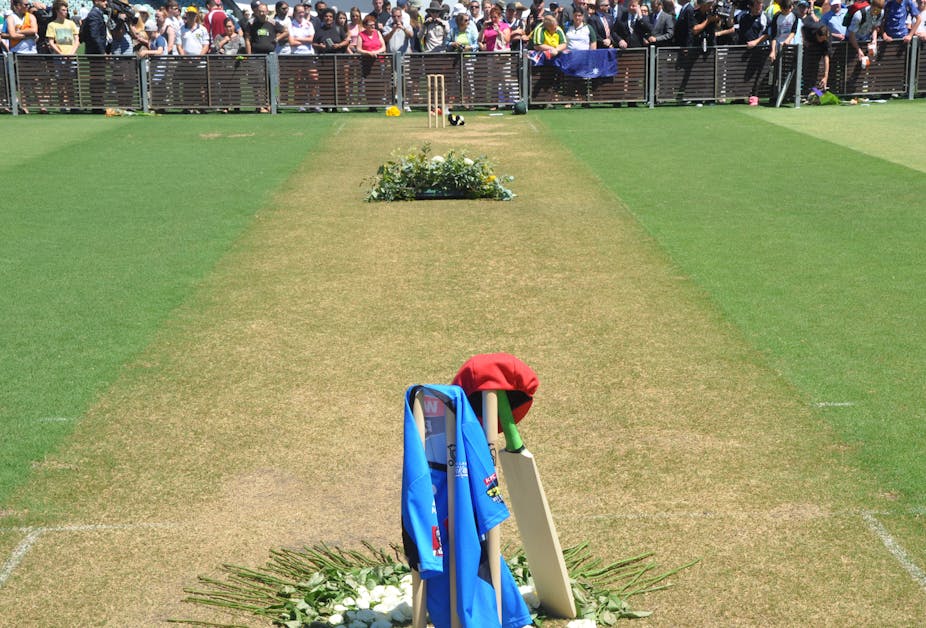The first cricket Test match of the Australia summer is usually a happy occasion. Its retro sights of white-flannelled figures and the comforting sound of bat on ball herald the holiday season even for those who don’t care much for the game. But not this time.
Australian batsman Phillip Hughes’ death on the field of play barely a fortnight ago is a reminder not of carefree fun, but of mortality. Players, officials and sports journalists have displayed the trauma on their faces. Legions of cricket fans, and even people who had never previously heard of Hughes, have publicly displayed their grief.
The much-coveted Google landing page carried the viral image of a leaning, unattended bat. Overseas football matches saw displays of sorrow for the death of a sportsman.
Days of saturation media coverage preceded the funeral in rurally picturesque Macksville attended by teammates, celebrities, politicians and locals. There was the usual glib talk of closure, but how can cricket and its followers return so quickly to business as usual and efficiently expunge the awful images of an incident given such intensive, repeated exposure?
If there is to be a genuine healing process it is necessary to confront some uncomfortable home truths. It has been all too easy to dismiss Hughes’ death as a “freak” accident. In part, this was legitimate reassurance to the bowler of the fatal ball, Sean Abbott, who could have scarcely imagined that a regulation bouncer to an armoured batsman would have such dire consequences.
But it is important to understand how the accident came to happen, and not simply to attribute it all to malign, capricious fate or rule out justifiable questioning of the staggering scale of the response to it – as the usually astute observer Greg Jericho has done.
Piling up all the apparently unique combination of factors in this case – “cricket, fame, youth, style, media attendance plus a multitude of other things [that] contributed to the response” – Jericho declared:
Let us honour him by not using his death to beat our own drum.
Certainly, any event as heart-wrenching and newsworthy as Hughes’ tragic death is certain to draw out all manner of axe-grinders and ideological opportunists, as well as those who are just trying to make some sense of what happened and to prevent its recurrence.
But accidents and the responses to them don’t just happen in isolation or speak for themselves. It is imperative to look beyond the moment, even if we feel a powerful compulsion to succumb to sentimentality’s warm embrace. The drum beat cannot be so easily stilled or its repercussions denied.
Last December, during the fractious Ashes tour by England, I wrote about the overt aggression of the Australian team, as embodied by Mitchell Johnson and his macho moustache, and its unbridled celebration of a “reborn 1970s cricket masculine archetype”.
There was not much duty of care on show then for the mentally fragile and heavily sledged English batsman Jonathan Trott. Australian captain Michael Clarke, who provided such strong support for Hughes’ family and wept movingly for his “little brother”, gained grudging respect in old-school ranks when caught by a microphone telling England’s Jimmy Anderson to face up to Johnson and “get ready for a broken fucking arm”.
In a sideshow in the nets, former Australian Test fast bowler Brett Lee broke a rib of vociferous middle-aged English journalist and batting “bunny” Piers Morgan.

The key lesson is that what happened to Hughes at the SCG could have occurred last summer or at any other time and place in the world of cricket. Over the last year, with much less publicity and some circumstantial differences, it already has on several occasions.
This does not mean that cricket is uniformly dangerous or that cricketers are homicidally inclined. Yet players and crowds may talk and chant about metaphorically killing the opposition – in Australia in the 1970s it seemed almost de rigueur.
While many excuse this behaviour as just exuberance and rhetorical overkill, cricket is emphatically not a bloodless video game. Most of those who watch its elite form receive a neatly packaged, sanitised screen version, spiced with hyped–up commercial television commentary. Slow-motion replays give little sense of the peril in which the players are placed. But sledging and hostile gestures are not mere melodramatic performances – as we have so painfully seen, not all of the actors leave this set safe and sound.
What happened to Hughes was a shocking reminder that a screen is only a two-dimensional representation and that the language of violence cannot be tritely quarantined from its physical implications. In recoiling from the spectre of gladiators sacrificed to baying Colosseum crowds, public and media responses were suffused with nostalgia.
Hughes was repeatedly represented as a Bradmanesque “boy from the bush”. This saddening tale of a young life cut short symbolically merged with the multitudes of hearty young men who will be commemorated in 2015’s Anzac centenary.
All this means a heavy emotional weight to carry into the Adelaide Oval for the game against India. Players and spectators will be closely scrutinised for signs of enduring change after Hughes’ death, but professional commercial sport has formidable momentum and resilience.
In the quieter moments, though, perhaps participants and witnesses will contemplate their own responsibility for fashioning a contemporary game that, though rarely visited by death, has too often courted dishonour.

